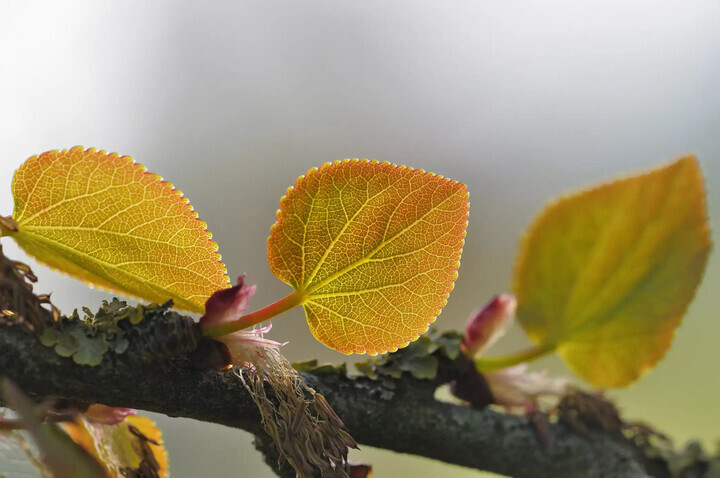The Katsura is a deciduous tree with a moderate to fast growth rate. It is of medium height, making it better suited to the average urban or suburban property than a very tall tree, such as the American beech tree (Fagus grandifolia). The katsura is known for the yellow color of its fall leaves, its rounded to pyramidal plant form, and the attractive way that its heart-shaped leaves line up opposite one another along the branches. It does best when planted in late winter or early spring.
| Botanical Name | Cercidiphyllum japonicum |
|---|---|
| Common Name | Katsura tree, Japanese Katsura |
| Plant Type | Tree |
| Mature Size | 40 to 60 feet tall and 25 to 60 feet wide |
| Sun Exposure | Full sun to partial shade |
| Soil Type | Rich, well-drained |
| Soil pH | Neutral to slightly acidic |
| Bloom Time | March or April |
| Flower Color | Plant is dioecious; flowers red on male trees, green on females |
| Hardiness Zones | 4 to 8 |
| Native Area | China and Japan |
How to Grow the Katsura Tree
Katsura trees' preference for rich soil means that you should not spare the compost in growing these trees. By mixing compost into the soil when you plant Katsura trees, you will not only be feeding your plants but also improving soil drainage.
Still, the Katsura tree is rather easy to grow because it tolerates a number of things that other trees may not, including:
Wet soil
Clay soil
Acidic soil
Salt
To help maintain evenly moist soil, it's a good idea to use mulch around these trees. Applying a layer of three inches of mulch over the soil surface after planting will help the ground underneath retain moisture. There is an added benefit of organic mulches (such as bark mulch): As they break down, they add further nutrients to the soil and improve its drainage, which is important to Katsura trees.
Light
Because they are understory trees (a tree that grow under the canopies of larger, taller trees) in the wild, Katsuras can be grown in partial shade. In fact, in the more southerly areas of their range, giving them a bit of shade can keep their leaves from becoming scorched in summer. In the North, though, give them full sun, because they achieve better fall-foliage color under these conditions.
Soil
It's most important that the soil is well-drained and relatively moist. Neutral to slightly acid soil pH is best, but the katsura can tolerate somewhat more acid as well as clayey soil.
Water
Katsuras have moderate watering needs overall but may need more frequent watering in dry areas, although it is somewhat drought-tolerant once established. Water as needed to keep the soil moist (but not wet) until the tree is well established, then water according to seasonal conditions.
Temperature and Humidity
Suitable for zones 4 to 8, this tree can tolerate a fairly broad temperature range and is not too picky about humidity. In damp climates or seasons, avoid watering from overhead to prevent leaf mildew.
Fertilizer
Fertilize katsura trees with a balanced fertilizer. being sure to soak the ground well afterward to ensure that the fertilizer goes down to the roots.
Varieties of Katsura Trees:
Red Fox Katsura tree (Cercidiphyllum japonicum 'Rotfuchs'): Smaller than the species tree (30 feet tall, with a spread of 16 feet), it is one of the most colorful types, bearing purplish-bronze leaves in spring, greenish-bronze leaves in summer, and orangey-bronze fall foliage.
Weeping Katsura tree (Cercidiphyllum japonicum 'Pendulum'): 15 to 25 feet high, with a similar to slightly greater spread, the branches of this even smaller type droop down, increasing visual interest.

Pruning Katsura Trees
Katsuras typically do not need pruning other than seasonal cleanup and maintenance. Check the tree each spring, and remove any suckers or dead branches.
Landscape Uses for Katsura Trees
The Katsura tree is widely grown in the Orient but is not as well known in North America. That is too bad because this plant has a few features that give it value. It is a nice choice for growers who are looking for a unique plant that will set their yards apart from their neighbors. And you do not have to worry about growing it around children or dogs: Katsura trees are not known to be poisonous, either to people or to pets.
The Katsura tree is valuable as a shade tree where a larger tree such as sugar maple (Acer saccharum), at 80 feet, would be too big. Its tidy form, attractive leaf shape, and fall color also make it suitable as a specimen. If great fall color is your main goal, grow the Red Fox cultivar. The small weeping katsura cultivar, however, has the prettiest form of any of the Katsura trees.
Trees Similar to Katsura
"Katsura" is the name of Cercidiphyllum japonicum in Japanese. The genus name of Cercidiphyllum indicates that the shape of the Katsura tree's leaves is reminiscent of the shape of the leaves on the redbud tree (Cercis genus). You can easily tell the two apart, though, from how their leaves are arranged on the trees' branches: Katsura leaves line up in pairs directly across from each other, while redbud leaves have an alternating pattern. The species name of japonicum reveals the part of the world where the katsura is indigenous.